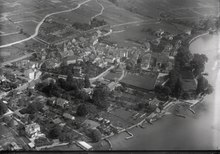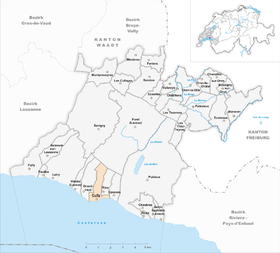Cully VD
| VD is the abbreviation for the canton of Vaud in Switzerland and is used to avoid confusion with other entries of the name Cully . |
| Cully | ||
|---|---|---|
| State : |
|
|
| Canton : |
|
|
| District : | Lavaux-Oron | |
| Municipality : | Bourg-en-Lavaux | |
| Postal code : | 1096 | |
| former BFS no. : | 5602 | |
| Coordinates : | 545 654 / 148804 | |
| Height : | 387 m above sea level M. | |
| Area : | 2.37 km² | |
| Residents: | 1785 (December 31, 2010) | |
| Population density : | 753 inhabitants per km² | |
| Website: | www.cully.ch | |
| map | ||
|
|
||
Cully ([ ky (j) i ], in the native Franco-Provencal dialect [ (a) kjyˈʎi ]) was a political municipality and capital of the Lavaux-Oron district in the canton of Vaud in Switzerland until July 1, 2011 . It merged with Epesses , Grandvaux , Riex and Villette to form the new political municipality of Bourg-en-Lavaux .
geography
Cully is 387 m above sea level. M. , eight kilometers south-east of the canton capital Lausanne (linear distance ). The village extends in Lavaux , on a promontory that protrudes slightly into Lake Geneva , at the foot of the vineyards of Mont de Gourze.
The area of the 2.4 km² municipal area comprised a section of the Lavaux on the north-eastern shore of Lake Geneva (around 2 km of the lakeshore line). The municipality floor extended northward from the lakeshore over the narrow shoreline and the steep slopes of the Lavaux, with the eastern border running along the Champaflon brook to the high plateau south-east of the Jorat . In the northeast the area extended to the Mont de Gourze , which is 925 m above sea level. M. formed the highest point of Cully. In the area of Cully, the watershed between the catchment areas of the Rhine and the Rhone is just 2 km north of the shores of Lake Geneva. The extreme north of the municipality has already been drained in a northerly direction towards the Broye and thus to the Rhine. In 1997, 28% of the municipal area was accounted for by settlements, 9% for forests and woodlands and 63% for agriculture.
The hamlet of Chenaux ( 530 m above sea level ) on a ledge in the vines above the village and several individual farms on the high plateau belong to Cully . Neighboring parishes of Cully were Grandvaux , Forel , Riex and Epesses .
population
With 1785 inhabitants (as of December 31, 2010) Cully was one of the medium-sized municipalities in the canton of Vaud. In 2000, 84.0% of the residents were French-speaking, 5.5% German-speaking and 4.3% Portuguese-speaking. The population of Cully was 880 in 1850 and 1101 in 1900. During the 20th century the population increased continuously until 1980 (1801 inhabitants); since then it has remained stable.
economy
Until the beginning of the 20th century, Cully was a predominantly agricultural village. Even today, viticulture on the perfectly sunny slopes of Lavaux (around 90 hectares) as well as agriculture and cattle breeding on the plateaus play an important role in the income structure of the population. Agriculture employs 22% of the workforce, while the secondary sector accounts for 6% and the service sector for 72% of the workforce.
To the west of the town, a small commercial and industrial area has developed over the past few decades, in which, among other things, construction and information technology companies have settled. In addition to everyday goods, the Cully business is also geared towards tourism. There are numerous wine shops. The Hôpital de Lavaux district hospital is located in Cully. Cully is also the seat of the Fondation pour l'étude et la protection de la mer et des lacs and the Association du Vieux-Lavaux . To the east of the village there is a small sport boat harbor and a campsite. The Cully Jazz Festival is held every year in the village . Thanks to the good transport connections and the attractive location, the village has developed into a residential community in recent decades. Many employed people are therefore commuters who work mainly in Lausanne and the Vevey - Montreux region.
education
In Cully, pupils can attend primary school, secondary school (since 1949) and Progymnasium (since the 1990s). In the second half of the 19th century, Cully temporarily had an industrial school .
traffic
The place is well developed in terms of traffic. It is located on the main road 9 , which leads from Lausanne along the lake shore via Vevey and Montreux into the Valais (with a local bypass). The next motorway connections to the A9 (Lausanne-Sion), which opened in 1974 and crosses the municipality, are Belmont (in the west) and Chexbres (in the east), each around 6 km from the village.
On April 2, 1861, the Lausanne – Villeneuve section of the railway line from Lausanne to Valais with a station in Cully was put into operation. A bus line takes care of the fine distribution in public transport, which operates the route from Cully via Chexbres to the Puidoux-Chexbres train station. Cully is also connected to other places adjacent to the lake via passenger shipping on Lake Geneva.
history

Cully has a long tradition of settlement. The earliest traces of human activity date from the Neolithic , when a pile-dwelling settlement was located on Lake Geneva near today's Moratel port . During the Roman era , the road from Lausanne to the Great Saint Bernard passed through the area. Some remains of the wall and coin finds have come down to us from this time.
The first written mention of the place took place in 967 under the name Cusliacum . Later the names Cusliaco (in the 12th century), Custiacum (1154), Cullie (1226), Cullye (1275) and Culye (1383) appeared. The origin of the place name is not clearly established. It could be derived from the Roman surname Coclius .
The first document in which Cully was mentioned confirmed the donation of the village by the then Burgundian king to the Besançon chapter . But because Cully was also subordinate to the parish of Villette, which belonged to the Bishop of Lausanne, there were repeated disputes and overruns until the chapter Besançon sold the place to the Bishop of Lausanne in 1246. This put Cully under the court of Lutry. In the 14th century, the residents were granted the right to hold a weekly market and fortify the village. Cully was given town charter and can now be described as a historic town.
With the conquest of Vaud by Bern in 1536, Cully came under the administration of the Bailiwick of Lausanne . Until 1598 the interests of the Bernese lords were represented by the Meier von Cully. After this family died out, the Kastlanei Villette was created, whose seat was still in Cully. After the collapse of the Ancien Régime , the village belonged to the canton of Léman from 1798 to 1803 during the Helvetic Republic , which then became part of the canton of Vaud when the mediation constitution came into force . In 1798, Cully became the capital of the Lavaux district, as it was in the central part of the district.
Cully was always ecclesiastically and, since the 17th century, also politically dependent on Villette. It was not until 1824, when the large municipality of Villette was divided, that Cully achieved the status of an independent political municipality. A project to merge the five independent municipalities of Cully, Epesses, Riex, Grandvaux and Villette failed in a vote on February 27, 2005 due to resistance from the people of Grandvaux. The merger finally took place on July 1, 2011. The new municipality is called Bourg-en-Lavaux .
Attractions
- Cully has a historic town center with narrow streets and patrician, town and winegrowers' houses from the 16th to 19th centuries. Hardly any remains of the earlier fortification walls can be seen; the three former city gates were torn down.
- The neo-Gothic Saint-Etienne church was built in 1865/1866 on the site of a medieval church. From gothic predecessor building the tower of the 15th century has been preserved.
- In the hospital chapel, which is now secluded, there is a remarkable painting (around 1580) depicting the judgment of Solomon.
- The Maison Jaune , built in 1641 and today the seat of the municipal administration, and the Bâtiment de Villette (essentially dating back to the 16th century) are listed buildings.
- Other important buildings are the Bâtiment Vallon (1673) and the Hôtel du Raisin , which was built in 1574 and remodeled in 1630 and which previously served as the town hall.
- The justice fountain with an octagonal fountain basin and a statue was created in 1643.
- A panoramic view of the Lake Geneva basin, the Alps and the Jura is offered from the Tour de Gourze observation tower on the 925 m high Mont de Gourze.
Web links
- Official website of Cully (French)
- Germain Hausmann: Cully. In: Historical Lexicon of Switzerland .
- Aerial views of the village
Individual evidence
- ↑ Florence Cattin: Cully VD (Lavaux). In: Dictionnaire toponymique des communes suisses - Lexicon of Swiss municipality names - Dizionario toponomastico dei comuni svizzeri (DTS | LSG). Center de dialectologie, Université de Neuchâtel, Verlag Huber, Frauenfeld / Stuttgart / Vienna 2005, ISBN 3-7193-1308-5 and Éditions Payot, Lausanne 2005, ISBN 2-601-03336-3 , p. 282.
- ^ Homepage of Cully ( Memento from January 10, 2012 in the Internet Archive )



